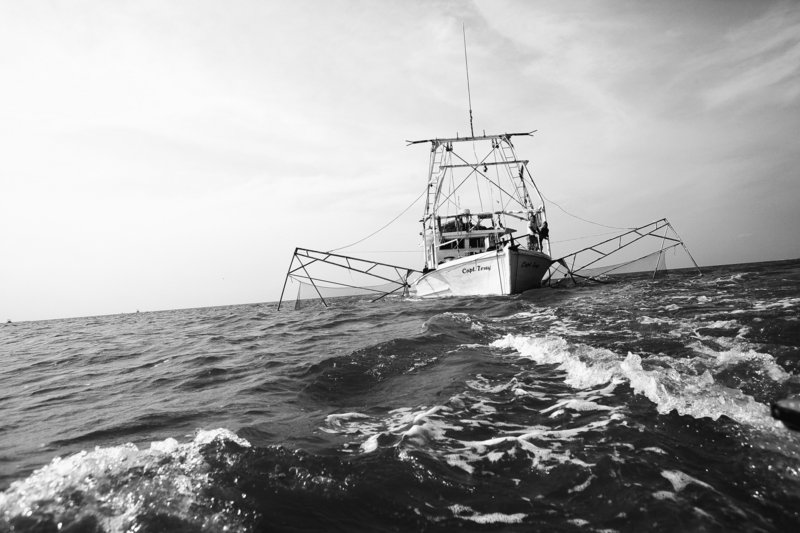GRAND ISLE, La. — Fishermen who spent much of the summer mopping up oil from BP’s spill got back to work Monday as the fall shrimping season in Louisiana’s coastal waters opened amid anxiety over whether the catch will be tainted by crude and whether anyone will buy it even if it is clean.
Scores of shrimpers headed out at first light, and early reports indicated a plentiful and clean catch.
“We’re not seeing any oil where I’m at. No tar balls, nothing,” said Brian Amos, a 53-year-old shrimper who trawled in his 28-foot skiff, The Rolling Thunder, in a bay near Empire.
It was a step toward normalcy for many coastal towns that have been in limbo in the nearly four months since the spill shut down fishing, an economic linchpin for dock owners, restaurants and many other businesses along the Louisiana coast. Louisiana ranks first in the nation in shrimp, blue crab, crawfish and oysters, and the state’s seafood industry overall generates an estimated $2.4 billion a year.
Also Monday:
• Georgia scientists said their analysis shows that most of the BP oil the government said was gone from the Gulf of Mexico is still there.
The scientists say as much as 80 percent of the oil still lurks under the surface. The Georgia team said it is a misinterpretation of data to claim that oil that is dissolved is actually gone. The report from University of Georgia and other scientists came from an analysis of federal estimates.
Earlier this month federal scientists said that only about a quarter of the oil remained and the rest was either removed, dissolved or dispersed.
• Retired Coast Guard Adm. Thad Allen, who is overseeing the oil spill crisis for the federal government, said it will take at least a week to permanently plug the well with mud and cement once he gives the go-ahead for the “bottom kill.” He said he is not sure when that will happen, because scientists are working on ways to perform the kill without further damaging the well.
• BP said it will give federal and state health organizations $52 million to help people dealing with stress and anxiety because of the spill, which began after the offshore drilling rig Deepwater Horizon exploded April 20, killing 11 workers. The oil stopped flowing in mid-July after BP put a temporary cap on the well.
Amos and his fellow shrimpers were working in Louisiana’s state-controlled waters, which extend three miles from shore. Shrimpers who ply those waters lost most of their spring season – which runs from mid-May to early July – because of the spill. The fall shrimping season runs from mid-August to December.
Shrimping is also open in state-controlled waters off Mississippi, Alabama, Florida and Texas. Federal waters, which are open nearly year-round for boats to trawl for bigger shrimp, remain closed to shrimping off Louisiana, Mississippi and Alabama, though some areas could open within days, depending on the results of extensive tests.
Laboratory tests on seafood from the gulf have shown little hazard from oil, and a test is being developed for the chemicals used to disperse the crude, though there is no evidence they build up in seafood. Still, shrimpers are worried that the public won’t want what they catch.
“I feel that we have had a bad rap on the perception of our product,” said Andrew Blanchard, who waited Monday for shrimp boats to arrive at his processing plant in Chauvin, La. Fewer arrived than normal, five versus the usual 20 on a normal opening day, but he said that was because most boats are still doing cleanup work for BP, not because of any problem with the shrimp.
Ravin Lacoste of Theriot said he believes his fellow shrimpers know better than to turn in a bad catch. “If you put bad shrimp on the market – we’re in enough trouble now with our shrimp,” Lacoste said. “You might go in the closed waters and catch more shrimp. But it ain’t worth it.”
Prices spiked soon after the rig explosion, fueled by fears that the shrimp would soon be unavailable. But then, despite state and federal assurances that the seafood reaching the market was safe, demand dropped and prices crashed a month ago.
The state of the industry was precarious even before the spill. For the past decade, shrimpers along the Gulf Coast have had to contend with hurricanes, high fuel prices and a flood of imported shrimp.
Louisiana’s shrimp harvest was valued at $240 million in 2000, but that dropped to about $133 million last year. The number of shrimp licenses issued by the state plummeted from about 44,000 in 1986 to 14,000 last year.
Still, there are reasons for hope. There were fears that the spill would kill large amounts of shrimp larvae. But Martin Bourgeois, a state fisheries biologist, said initial observations show they may have made it through intact.
Send questions/comments to the editors.



Success. Please wait for the page to reload. If the page does not reload within 5 seconds, please refresh the page.
Enter your email and password to access comments.
Hi, to comment on stories you must . This profile is in addition to your subscription and website login.
Already have a commenting profile? .
Invalid username/password.
Please check your email to confirm and complete your registration.
Only subscribers are eligible to post comments. Please subscribe or login first for digital access. Here’s why.
Use the form below to reset your password. When you've submitted your account email, we will send an email with a reset code.